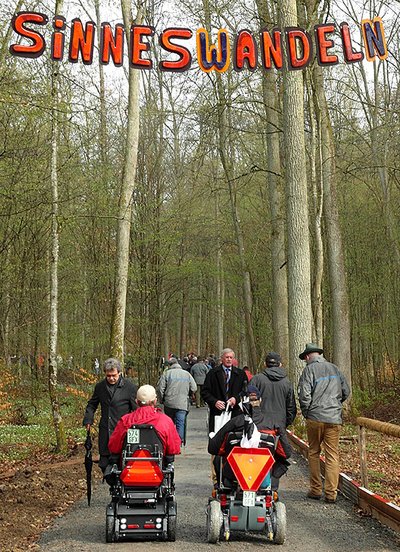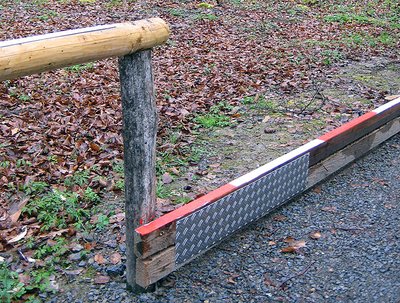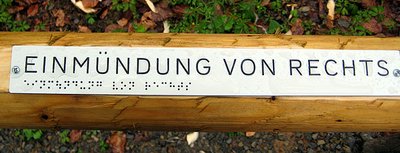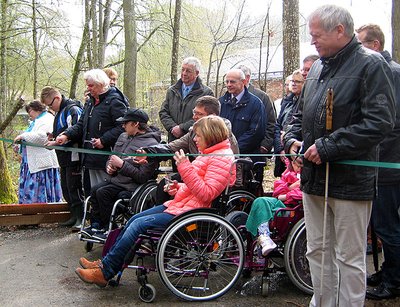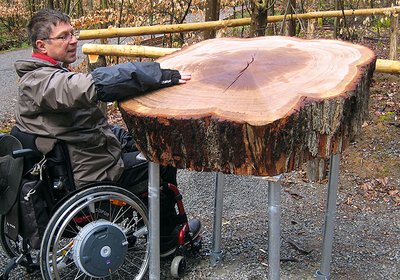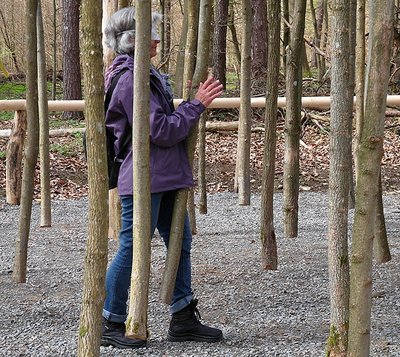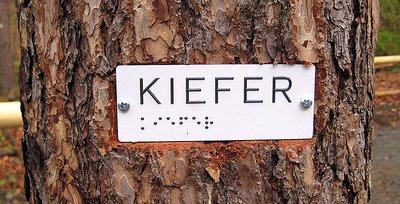Given the wealth of sensory impressions and sensations it offers, the forest is a place that many people enjoy visiting. Forest educational centres and forest experience trails in particular are very popular, especially with families and nature fans. These facilities are open in principle to everyone, but the needs of all visitor groups are not necessarily taken into consideration during their construction. People with disabilities – those dependent on a walking-aid or wheelchair, for example, or the visually impaired - can often only take advantage of these facilities if they have assistance.
In the beginning was the idea
In 2013, it was decided to create a barrier-free forest experience trail at the Gramschatzer Wald forest experience centre that would give as many people as possible access to the joys of the forest. Gramschatz seemed the obvious site, as the key infrastructure was already available, including parking facilities and toilets for the disabled. The idea of the forest experience trail was to open up the forest as an area of experience for people with all sorts of different disabilities, whilst at the same time offering interesting experiences for people without disabilities, too. The team was able to draw on ideas from colleagues in Stuttgart, who had created a barrier-free forest experience trail of their own at the "Haus des Waldes" (House of the Forest) there in 2015.
Assistance from "the experts"
It quickly became clear that a trail like this could only be successful if people with disabilities took part in its development. As there is a whole series of institutions in Würzburg for people with disabilities, it did not take long to find interested and highly committed people willing to get involved. Various institutions provided all sorts of tips at the planning stage, and a rolling walker-user, a blind person and a wheelchair-user were also able to help regularly with their experiences and suggestions.
Barrier-free access has many faces
Accessibility begins with the length of the trail. For the elderly or people with walking disabilities, long distances often represent a major if not impossible challenge. The length of the SINNESWANDELN trail has thus been adapted accordingly. The trail is 1.1 km long and incorporates only very gentle slopes. There are lots of benches and even a grouped arrangement of seating along the way for anyone needing a rest. The surface of the path is mineral concrete with a high proportion of fine-grained material, compacted several times with a roller. This frees wheelchair and rolling walker-users from the problems caused by friction or sticking on conventional gravel tracks in the forest, thus making the path easily negotiable for them, too. So that this remains the case on a long-term basis, the path must of course be maintained permanently with accessibility in mind.
The trail follows a circular route and should ideally be explored in a clockwise direction. A series of planks and hand-rails has been installed along the right hand side of the trail to guide visually impaired visitors (Fig. 2). Blind visitors can use the planks at ground-level to find their way along the trail using a cane. Information concerning the route and the various stations (in German only) has been mounted along the hand-rails. All lettering and objects on the signs are raised and can thus be felt easily. The information is also provided in Braille (Fig. 3).
Blessing and dedication
Finally, at the beginning of 2016, the fruits of three years of hard work could be harvested, and the SINNESWANDELN trail was officially opened. Many people with disabilities were present, as well as representatives from politics and society, and the members of charitable associations. A dean of the protestant church and a pastoral assistant from the Roman Catholic church were there to offer a blessing for the use and users of the path, expressing the hope that it would lead to many life-enriching meetings between people both with and without diabilities. Then the green ribbon was cut through, symbolising the removal of the last barrier and the opening of the path (Fig. 4).
Stations along the route
The SINNESWANDELN trail has a total of five stations. At the "feeling" station, the focus is on the sense of touch. Here it is possible to use your hands to understand the tree as a natural work of art and useful natural commodity. Can you recognise an oak by feeling its bark? We can count the annual growth rings on the cross-section of a tree trunk with our fingers - possible quite comfortably even from a wheel-chair (Fig. 5). How does an old tree feel in comparison with a young tree? How does the tree continue underground? And the forest soil also offers special experiences for our feet - on the barefoot trail.
At the "listening" station, we experience the healing tranquillity of the forest. Birdsong, the whistling of the wind, the cracking of branches - all of this and much more is here to surprise us. The forest loungers in this area are an open invitation to rest and enjoy the tranquillity of the forest a little longer. But the forest can also produce noises, so you can try listening to them through the ear trumpet. Or what about trying the tree telephone? A highlight here is the "forest bed", cushioned with wood chips, which may well tempt you to repose on the forest floor.
At the "smelling and tasting" station, it is also possible to experience the forest with our mouths and noses. As well as enjoying the wonderful natural fragrances of spring, summer or autumn, you can use our scent organs to conjure up and savour all sorts of other intense natural scents. There are also information boards telling you all about edible herbs, mushrooms and trees.
There is all sorts going on in the forest - many animals, plants and other living organisms feel at home here. At the "seeing" station you can zigzag your way through the "forest" of hanging tree trunks (Fig. 6), explore your surroundings through the periscope, or stamp your own animal tracks.
The final station on the trail will appeal to all of your senses. Can you keep your balance on the wobbly board? Or get to the highest point on the climbing net? And you will need your senses to throw things at the target, too - especially if you try and do it "blind".
Between or at the stations you will often find "trees to feel" next to the benches. The idea here is for you to explore the different tree species through your sense of touch (Fig. 7). You can also take a look at the crowns of the trees from the nest swing - or simply relax in it and allow your senses to chill.
A lot still to do
The SINNESWANDELN barrier-free forest experience trail is now open to all visitors. This does not however mean that the project has been completed. The team at the Gramschatzer Wald forest experience centre do not see the regular supervision and maintenance of the path as their only tasks. They very definitely also see the continuous improvement and extension of the forest experience facilities as a challenge for the future. Any remaining hurdles must be lowered or removed, and new activities must be developed to ensure that the path remains attractive. And for that to happen, they need your input! If you have any ideas or suggestions for improvements, please let the forest experience centre team know - because only then can they remove all barriers and include everyone. It remains to be hoped that this example will set a precedent for projects in other regions in Bavaria and beyond.

